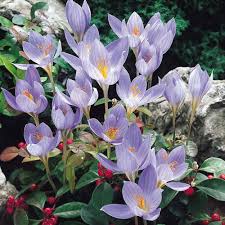
Be-a-Better-Gardener, Fall-Blooming Bulbs
Crocus speciosus ‘Conqueror’ — a perfect choice in fall blooming bulbs that naturalize and spread.
By Thomas Christopher
We think of spring as the season for flowering bulbs, but in fact there is a choice selection — too often overlooked by gardeners — that bloom in the fall. The fall bloomers are just as reliable as the spring-blooming bulbs and share a crucial characteristic: they provide fresh, bright color at a time of year when it is most wanted. For just as you can be hungry for color at winter’s end, so too you may find yourself wanting something other than the russets of fall foliage. If you do, you’ll find these fall-blooming bulbs to be the perfect autumnal pick-me-up.
The backbone of the fall bulb display are the so-called fall crocuses. Chief among these is Crocus speciosus. Native to western Asia, this plant blooms as early as September, the flowers rather suddenly popping up out of the soil; the leaves, with their silvery central stripe, emerge after the flowers’ surprise. The color of the flowers is a sort of lilac blue; the petals are veined with darker purple and the throats of the flowers are white. All in all, a very attractive, though humble display: the plants reach a height of only 4 inches. Given a sunny or semi-shaded spot with well-drained soil and allowed to flourish undisturbed, Crocus speciosus is likely to naturalize and spread. Slightly larger than the species-type, with larger, violet-blue flowers is the domesticated version of this plant: C. speciosus ‘Conqueror.’ ‘Oxonian,’ another garden variety of this plant, has darker, purple-blue flowers.
Crocus speciosus is hardy to USDA Zone 4, which makes it a good candidate for my garden on a chilly hilltop in western Massachusetts. Those with the slightly warmer climate of USDA Zone 6 can also decorate their gardens with the saffron crocus, C. sativus. This plant is the source of the very costly spice saffron, and some sellers suggest that buyers harvest their own crop. This is attractive in principle but unlikely in practice, as the saffron spice is borne on tiny, thread-like structures at the heart of the flower, and the gardener is unlikely to tweeze enough of these out of his or her blossoms to make a significant culinary impact. Nevertheless, the saffron crocus earns a spot in a sunny, well-drained bed with its handsome, pale purple flowers. This species, too, if located in a suitable spot and left undisturbed should prove reliably perennial and even multiply.
The appetizing qualities of crocuses make them a target for squirrels, who will even follow after the gardener, unearthing and eating the freshly planted corms (technically, crocuses produce “corms” rather than bulbs). If squirrels are a problem for you, try another fall bloomer: colchicums. These are toxic to squirrels, voles and deer and so are generally left alone by garden pests – gardeners, of course, should avoid eating them as well.
Colchicums are often marketed as “autumn crocuses,” which they are not. Indeed, they are not even closely related to the crocuses. Their flowers are similar, however, and they bloom on more or less the same schedule. A better common name is “naked ladies,” which refers to the fact that colchicum flowers emerge without accompanying leaves, for the foliage doesn’t appear until spring. There are many species and cultivars of colchicums available by mail order, and depending on the type, the flowers may be white or some shade of pink as well as pale violet. One of the most interesting is ‘Waterlily’ which bears mauve, double flowers that do indeed look like miniature waterlily blossoms.
Unlike the spring-blooming bulbs, the fall-bloomers offer near-instant gratification. Order them now; they arrive from the nursery, typically, in September and should be planted right away to bloom during their first fall in your garden.
Outstanding sources of fall crocuses and colchicums include Brent and Becky’s Bulbs (https://www.brentandbeckysbulbs.com/), a great company that offers a “Bloomin’ Bucks” fundraising program that returns a portion of its sales to Berkshire Botanical Garden at your request. These donations help fund the Garden’s bulb show held each spring in its Fitzpatrick Greenhouse. Other bulb sources include McClure & Zimmerman (https://www.mzbulb.com), and, locally, White Flower Farm (http://www.whiteflowerfarm.com/) which is headquartered in Morris, Connecticut and which offers selections of most of its bulbs in its retail store as well as by mail order. However you acquire them, though, these bulbs will prove one of fall’s notable pleasures.
Thomas Christopher is the co-author of “Garden Revolution” (Timber Press, 2016) and is a volunteer at Berkshire Botanical Garden. berkshirebotanical.org
Be-a-Better-Gardener is a community service of Berkshire Botanical Garden, one of the nation’s oldest botanical gardens in Stockbridge, MA. Its mission to provide knowledge of gardening and the environment through 25 display gardens and a diverse range of classes informs and inspires thousands of students and visitors on horticultural topics every year. Thomas Christopher is the co-author of Garden Revolution (Timber press, 2016) and is a volunteer at Berkshire Botanical Garden. berkshirebotanical.org.


